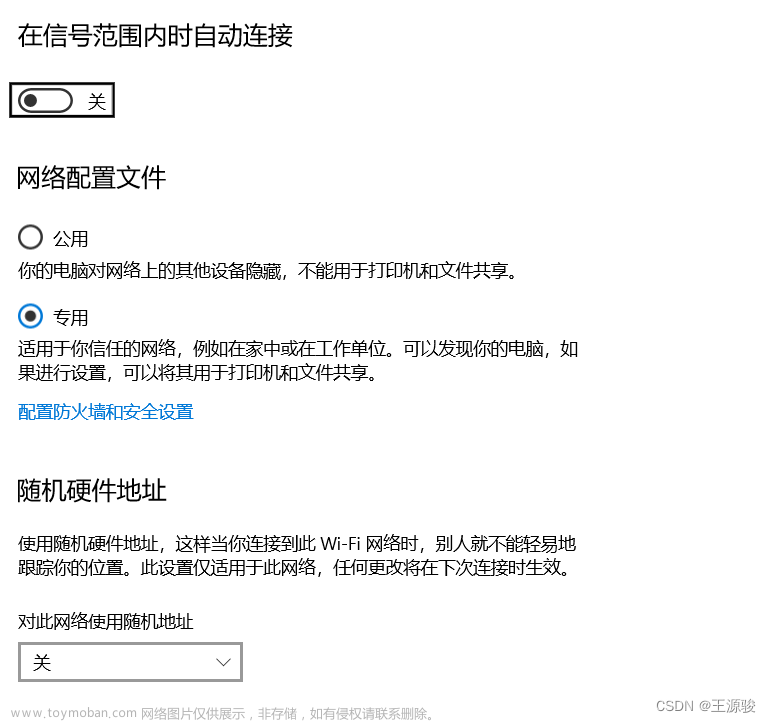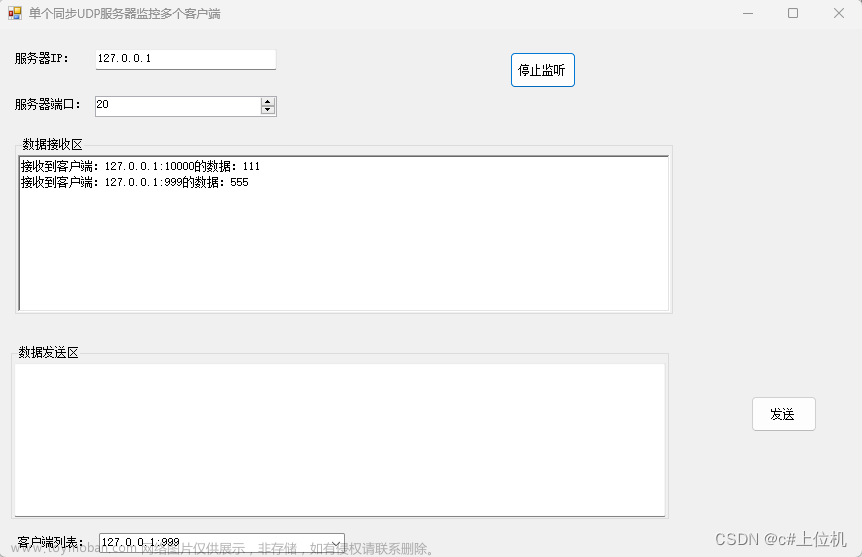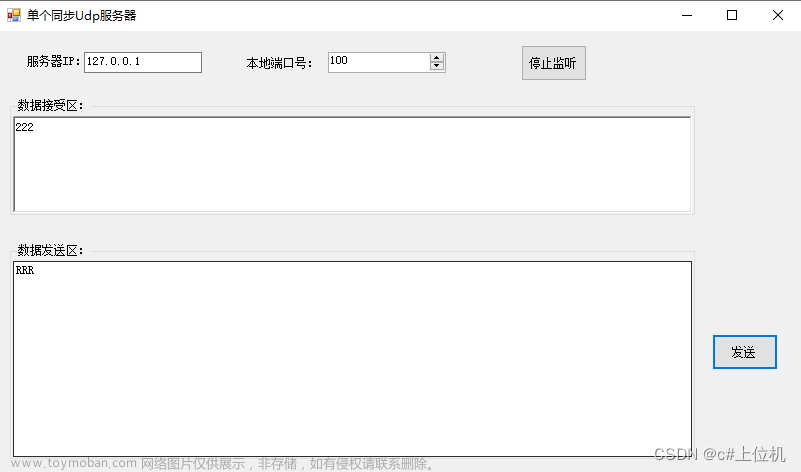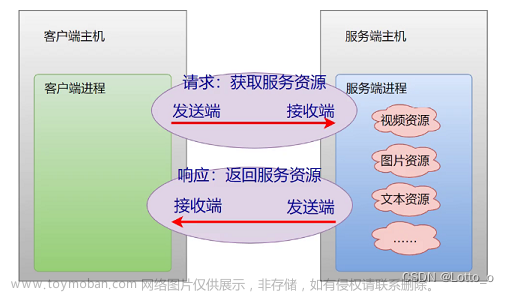1. 代码
//UdpClient.h
#ifndef UDPCLIENT_H
#define UDPCLIENT_H
#include <QtNetwork>
class Ex2; // 声明类
class UdpClient : public QObject
{
Q_OBJECT
public:
explicit UdpClient(Ex2 *ui = nullptr);
~UdpClient();
void Send(QByteArray buf,QHostAddress addr, int port);
void Send(char *buf,int length,QHostAddress addr, int port);
void Send(char *buf,int length);
void Send(QByteArray buf);
void Receive();
bool Close();
bool Open(QString ip,int port);
void SaveIpPort(QHostAddress ip,int port);
private:
Ex2 *pUi;
QUdpSocket *socket;
QHostAddress addr;
int port;
signals:
};
#endif // UDPCLIENT_H
//UdpClient.cpp
#include "UdpClient.h"
#include "ex2.h"
#include "ui_ex2.h"
UdpClient::UdpClient(Ex2 *ui)
{
socket = new QUdpSocket();
pUi = ui;
connect(socket,&QUdpSocket::readyRead,this,&UdpClient::Receive);
}
UdpClient::~UdpClient()
{
delete socket;
}
bool UdpClient::Open(QString ip,int port)
{
socket->close();/*取消绑定端口号使用:udpsocket->close()方法*/
QHostAddress ipAddr = QHostAddress(ip);
SaveIpPort(ipAddr,port);
socket->bind(ipAddr,port);
return true;
}
bool UdpClient::Close()
{
socket->close();
return true;
}
void UdpClient::SaveIpPort(QHostAddress ipAddr,int ipPort)
{
addr = ipAddr;
port = ipPort;
}
void UdpClient::Send(char *buf,int length,QHostAddress addr, int port)
{
QByteArray arr(buf,length);
socket->writeDatagram(arr,addr,port);
socket->flush();
}
void UdpClient::Send(char *buf,int length)
{
QByteArray arr(buf,length);
socket->writeDatagram(arr,addr,port);
socket->flush();
}
void UdpClient::Send(QByteArray buf,QHostAddress addr, int port)
{
socket->writeDatagram(buf,addr,port);
socket->flush();
}
void UdpClient::Send(QByteArray buf)
{
socket->writeDatagram(buf,addr,port);
socket->flush();
}
//12 34 A1 A2 -> "12 34 A1 A2"
QString ByteArrayToHexString(QByteArray data)
{
QString ret(data.toHex().toUpper());
int len = ret.length()/2;
for(int i=1;i<len;i++)
{
ret.insert(2*i+i-1," ");
}
return ret;
}
void UdpClient::Receive()
{
QHostAddress addr; //用于获取发送者的 IP 和端口
quint16 port;
//数据缓冲区
QByteArray buffer;
while(socket->hasPendingDatagrams())
{
//调整缓冲区的大小和收到的数据大小一致
buffer.resize(socket->bytesAvailable());
//接收数据
socket->readDatagram(buffer.data(),buffer.size(),&addr,&port);
//显示
QString str0 = ByteArrayToHexString(buffer) +" ";
if(!buffer.isEmpty())
{
QString str = pUi->ui->textEditMy1->toPlainText();
str += str0;
//刷新显示
pUi->ui->textEditMy1->setText(str);
}
}
}
//Ex2.cpp
#include "ex2.h"
#include "ui_ex2.h"
int static cnt = 0;
Ex2::Ex2(QWidget *parent)
: QDialog(parent)
, ui(new Ui::Ex2)
{
ui->setupUi(this);
....
//UDP
udpClientSocket = new UdpClient(this);
ui->lineEditUdpIp->setText("192.168.9.123");
ui->lineEditUdpPort->setText("6000");
}
void Ex2::on_pushButtonUdpConnect_clicked()
{
if(ui->pushButtonUdpConnect->text()==tr("创建"))
{
if(udpClientSocket->Open(ui->lineEditUdpIp->text(),ui->lineEditUdpPort->text().toInt()) == true)
{
ui->pushButtonUdpConnect->setText("取消");
}
}
else
{
udpClientSocket->Close();
ui->pushButtonUdpConnect->setText("创建");
}
}
void Ex2::on_pushButtonUdpSend_clicked()
{
//获取文本框内容并以ASCII码形式发送
uchar buf[13];
int i=0;
buf[i++] = 0xAA;
buf[i++] = 0x55;
buf[i++] = 0xAA;
udpClientSocket->Send((char *)buf,i);
}
//Ex2.h
#ifndef EX2_H
#define EX2_H
#include <QDialog>
#include <QtSerialPort/QSerialPort>
#include <QtSerialPort/QSerialPortInfo>
#include ".\UDP\UdpClient.h"
QT_BEGIN_NAMESPACE
namespace Ui { class Ex2; }
QT_END_NAMESPACE
class Ex2 : public QDialog
{
Q_OBJECT
public:
Ex2(QWidget *parent = nullptr);
~Ex2();
Ui::Ex2 *ui;
UdpClient *udpClientSocket;
private slots:
void on_pushButtonUdpConnect_clicked();
void on_pushButtonUdpSend_clicked();
private:
//Ui::Ex2 *ui;
QSerialPort *serial;
};
#endif // EX2_H
2. 效果
以上代码可以实现UDP收发功能。 文章来源地址https://www.toymoban.com/news/detail-648495.html
文章来源地址https://www.toymoban.com/news/detail-648495.html
文章来源:https://www.toymoban.com/news/detail-648495.html
到了这里,关于Qt 8. UDP客户端通信的文章就介绍完了。如果您还想了解更多内容,请在右上角搜索TOY模板网以前的文章或继续浏览下面的相关文章,希望大家以后多多支持TOY模板网!













